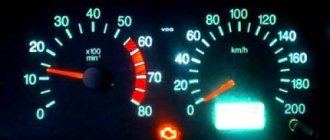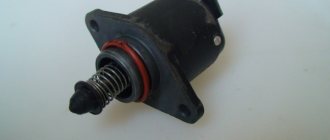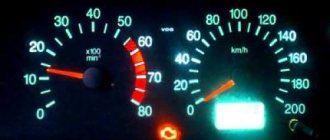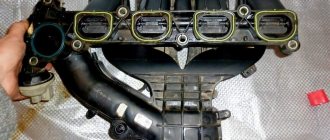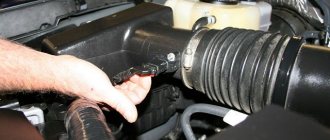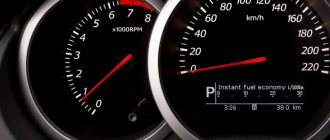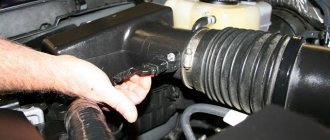Let's list them.
- The most basic is a malfunction or failure of the mass air flow sensor.
- No less common is the breakdown of the idle air control valve.
- A crankshaft position sensor providing incorrect information to the control unit can also be the root cause of a high or floating idle.
- The throttle position sensor may also be to blame.
- It happens that for some reason the gas pedal does not return all the way back. Moreover, this happens both because of a banal malfunction of the cable, and because of something completely ridiculous - for example, after washing the car, they covered the driver’s mat in such a way that the tip of the mat began to touch the pedal.
- The air filter is very clogged. Because of this, the combustion mixture is too rich in gasoline, again resulting in high idle speeds.
- The cable came off the throttle valve.
- Engine temperature sensor faulty. It gives the car’s “brains” incorrect values, which increase the crankshaft speed, thinking that the engine is cold.
As you can see, we have before us a whole forest of very different reasons why high revs appear! Next, we will take a closer look at the most typical, plus the most common problems associated with the problem described. At the same time, we’ll figure out how to eliminate them with our own hands.
Ways to eliminate the “sore”
If such a problem occurs, you need to look for which node is to blame analytically, checking all the specified sensors
First, let's consider the following option for correcting the problem situation. Let's assume that a VAZ 2110 has high revs. An examination of the suspected components for faulty components showed that the throttle position sensor has traces of rust. It is located directly above the throttle valve. Measurements with a voltmeter showed that when the engine is idling, the voltage on it remains high - which means it does not close the damper.
How to fix the problem? For this we only need a screwdriver. Let's begin the procedure.
- By disconnecting the terminal block and also unscrewing two screws, we dismantle the assembly. We notice that traces of rust inside interfere with the movement of the wheel that regulates the position of the damper.
- We fill the insides of the defective device with a penetrating anti-rust aerosol.
- Use a development screwdriver to turn the wheel.
- We reassemble in reverse order.
Check to see if the engine idle speed is now high. The problem should go away.
Now let's look at another case. Let's say we have high idle speed in a VAZ 2114. This is what we do when faced with this situation.
When clarifying the circumstances of the problem under investigation, we always initially check the operation of the idle speed sensor. This device consists of a needle built inside an electromagnetic coil. The needle either moves inside the coil, moving away from the hole in the throttle pipe, or moves out, closing this hole, thereby stopping the supply of air for combustion of the mixture.
This element is located at the throttle valve, opposite the gas pedal cable. To diagnose it, we pull out the terminal block from it, start the car, after which we see that we still have high engine speeds that have not changed at idle. Then we remove this defective unit, then clean it or replace it. For work we take:
Causes of the problem
Quite often, VAZ 2109 owners are faced with a problem when the carburetor does not hold speed while idling, and the engine simply stalls. There can be many reasons, and they are all united by a number of characteristic features.
The first reason is a clogged idle jet. Even though the fuel supply system has 2 filters (coarse and fine), even one speck may be enough to clog the nozzle.
Also, the fine filter itself may become clogged. This often happens when the filter was not replaced with a new one in time. Less commonly, malfunctions in the idle system occur.
There is no difference at all between the symptoms for any of the causes of the problem. Determining what exactly needs to be cleaned or changed can only be done through a visual inspection or diagnostics.
Also, sometimes the revs not only disappear completely, but also float. At the same time, the VAZ 2109 car does not stall. In this case, to the above reasons, you should add: a faulty solenoid valve or idle speed sensor.
If the idle speed of a VAZ 2109 (carburetor) fluctuates?
The first thing that the owner of a VAZ 2109 car who is faced with such a problem should know is that the carburetor itself is not always to blame. It may turn out that the ignition system or power system is faulty. Problems usually start when the car is warm. And here the reasons are the same for Ozone, Solex and others.
Let's start with the main known symptoms of this idle problem.
- VAZ 2109 carburetor idle speed floats;
- individual popping sounds are heard in the muffler or carburetor;
- there are gaps during operation of the engine cylinders;
- The speed changes, sometimes up, sometimes down.
Causes of the “disease” and ways to eliminate them:
- Firstly, the problem may be due to the fact that the VAZ 2109 carburetor was adjusted incorrectly. Usually - towards a leaner combustible mixture. This misunderstanding can be eliminated simply - with the help of “quality” and “quantity” screws. This has already been discussed in the article.
- The second common cause is a faulty solenoid valve. If the valve is faulty, the flow of fuel into the idle system is blocked. If, while the engine is running, you quickly remove and put the wire back on the valve, you should hear a click. This indicates that the valve is in working order. If this is not the case (there was a click), then we check the forced idle economizer system itself.
- The third problem is dirt getting into the jets and channels in the idle system. They can be blown out under pressure by first placing a certain amount of cleaner in the valve hole.
- Excess air enters the fuel mixture. "Suction." This usually causes the car engine to “trouble.” There is a video on this topic: it explains in detail what it is and how to deal with it.
- The fuel level in the float chamber is too high or too low. To do this you need to adjust it. You can find out more about this here:
- If you have checked all these options, but your VAZ 2109 (carburetor) still idles, then you need to check whether the VAZ 2109 (carburetor) air filter is clogged.
Air filter for a VAZ 2109 car with a carburetor engine:
Similar malfunctions on Samara can occur both during improper operation and as a result of exposure to unfavorable conditions, including weather, humidity, and temperature.
Checking all variants of the malfunction that led to floating speed should be carried out by professionals. If you have difficulties with diagnostics, it is best to seek advice and repair from a car service center.
Carry out diagnostics in a timely manner, and adjusting the VAZ 2109 carburetor is a mandatory procedure even for those cars that were recently purchased.
If you carry out the check in a timely manner, then you may not need such an unpleasant procedure as repairing a VAZ 2109 carburetor.
Be careful in all actions you perform during the inspection. Some parts can be easily damaged - follow the instructions strictly.
And finally, the most visual video about the situation when the idle speed of a VAZ 2109 (carburetor) fluctuates:
You can also read on this topic:
Car gearbox and its purpose
Which xenon is best to install on your car?
Tuning a VAZ 2115 with your own hands is impressive
Still dreaming of big wheels?
How to increase the power of a VAZ 2109 engine (carburetor) with your own hands
Alex S January 10, 2014
Published in: Useful tips and car devices
Tags: Advice for motorists
When releasing the gas, the speed is increased or “freezes”: common malfunctions
Let's start with the fact that on many cars with an injector, the ECU raises the speed while the internal combustion engine is warming up. This is necessary to ensure that the power unit operates stably after a cold start.
However, after the temperature rises, the control unit reduces the idle speed, bringing it to normal. On many cars with a carburetor, the driver independently increases the speed during warm-up, using the so-called “choke”.
Moreover, after the engine is warmed up, the normal idle speed is, on average, 650-950 rpm. If you press the gas and release the accelerator, the speed should increase, and then decrease again to the specified values.
- So, let's start with common carburetor problems. Often the engine speed does not drop due to problems with the throttle valve. For example, when the driver steps on the gas, the throttle must be opened wider to allow more air to enter the cylinders to burn fuel. After the gas pedal is released, the throttle closes and the speed decreases.
If the damper does not close completely, an over-enriched mixture enters the cylinders, and the speed is increased. The cause may be severe contamination of the throttle assembly or damage to the valve itself (deformation). First you need to clean the damper; carburetor cleaning liquid is suitable as a cleaner.
We also recommend reading the article about why the idle speed is increased. From this article you will learn about the reasons for high idle speed on an injection or carburetor engine, as well as methods for diagnosing and repairing this problem.
We also note that the damper does not close tightly even when the drive cable is worn out. In this case, the cable must be replaced. On carburetor cars, engine speed often does not drop even if the gasket between the carburetor and the cylinder head has failed. The culprit may also be an intake manifold that is damaged.
The main task is to find the correct ratio of fuel and air. Often, a high level of fuel in the carburetor float chamber also leads to increased speed. The check should begin with the needle valve.
- Now let's move on to the injector. Please note that on many injection cars, after cleaning the throttle valve, the assembly also needs to be additionally “trained”. As for problems, the injection system itself is more complex, that is, there are more reasons for high speeds compared to the carburetor.
In simple words, if the specified sensor gives an incorrect signal, the ECU considers that the engine is cold and activates the warm-up mode. In this case, the control unit raises the speed so that the power unit operates stably and reaches operating temperature faster.
Special attention should be paid to gaskets, since air leaks can lead to disruption of mixture formation. This means that you need to separately inspect manifold gaskets, injector seals, etc.
A little history
Despite the fact that the model seems old, its release was planned in March 1990, but happened a little later. In December 1990, the VAZ-21099 began to be produced in large series. The Ukrainian plant assembled this car until 2011 from Russian special vehicle kits.
The version from Ukraine had a slightly different name - ZAZ-21099. VAZ-21099 was produced under various names. They all differed in interior, details, year of production and country of assembly. Export names of VAZ-21099:
- Saloon
- Lada Samara
- Lada Sable
- Lada Sagona
- Lada Forma
- Lada Victory
All these cars had the common name “Samara”. But the VAZ-21099 had significant differences from everyone else.
- The front part of the body had long wings.
- Longer hood.
- No plastic “beak” at the front.
- New radiator grille.
- The instrument panel is gray (in other models the dominant color is brown).
This is how people of that time remember this car. But in 2004, the VAZ-21099 was completely discontinued at AvtoVAZ and replaced. Instead of the old, well-known model, the VAZ-2115 appeared. This is what made Ukrainian collectors continue to collect the legend. However, in 2011 this car was discontinued in all countries.
Together with it, they stopped producing the VAZ-21093. VAZ-21099 Victory is considered the most advanced model. Its most important advantage is that it had standard machine parameters (4x4). However, it has only a few improvements from the old model. Added.
- Rear axle gearbox from Volkswagen Golf Syncro.
- Viscous coupling.
- Angular gearbox.
- Transmission.
Victory is also distinguished by incredible dynamics, since the engine is forced. Its cross-country ability met all standards, which was perfectly possible with all-wheel drive. But times have passed, and the model has not received wide recognition. Therefore, the enterprise soon ceased its work.
Many people today prefer this car for two simple reasons.
- In terms of price, it is much cheaper than modern foreign cars, easy to maintain, and has inexpensive spare parts.
- Patriotism and the desire to preserve the legend.
But despite the fact that the reasons are compelling, and the car is of really good quality, times have taken their toll, and therefore, no matter how much one would like to admit it, the car is capable of breakdown. The carburetor is the first to suffer.
Troubleshooting
The idle jet located in the float chamber must be removed and checked for debris or debris. If debris is found in the nozzle hole, it must be blown out and washed with gasoline. If there is no debris in the hole, then we continue to look for the cause further.
We have examined the carburetor, now we can move on to the fine filter. Look at the condition of the gasoline in the filter sump. If there is no sediment at the bottom, the filter is still in good condition. If there are at least some particles at the bottom, it needs to be urgently replaced.
Old and new filter
After you have cleaned the carburetor and changed the fine filter, start the VAZ 2109 and check its operation at idle. If the speed still fluctuates or the engine stalls, the idle speed sensor may be the cause.
You can check the sensor in the following way: disconnect the wires from it and check it with a voltmeter. We put the negative wire to ground, and the positive wire to the block connector. Turn on the ignition and monitor the instrument readings. The sensor should produce a voltage of 12 volts. If there is no such current, then the sensor is most likely faulty.
If, after the procedure, it turns out that the sensor is in normal condition, but there are still no changes (the speed floats and the engine stalls), then the last option remains - the solenoid valve. It is quite difficult to check it, therefore, it is easier to install a new one.
Now, your VAZ 2109 car should work stably, both at idle and while driving. If the engine still stalls, although the speed no longer fluctuates, then the reason is much more serious, and most likely, special diagnostics and specialist intervention will be required.
Sometimes such a nuisance happens on the way, the driver finds himself in a situation where the engine of a VAZ 2109 stalls in the middle of the road and it is impossible to start the car further. The most interesting thing in such a situation is that there were no traces of any signs warning (foreshadowing) these problems, the car drove as usual, there was no “sneezing” or “shooting in the muffler.” Since the problem is common, our instructions will tell you what to do in a situation such as a sudden stop of the engine and poor starting. We will consider in detail all the main reasons that cause the engine to stop at idle and while driving. And also the reasons why it does not start when warm and how to solve this kind of problem.
Unstable idling of the engine with carburetor 2108 Solex and 2105, 2107 Ozone
Unstable idling of a car engine with a carburetor 2108, 21081, 21083 Solex or 2105, 2107 Ozone is one of the most common malfunctions. In addition to the discomfort of operating a car with a shaking engine that is about to stall, a car owner faced with such a problem must be prepared for a rapid decrease in its service life, an increase in fuel appetite, loss of power, throttle response, etc. It should immediately be noted that these reasons typical for a warm car engine idling with the choke fully open and the throttle closed. Unstable engine operation in other modes may have other reasons and will be discussed in a separate article.
— The engine is unstable at idle. It vibrates, “troits”, there may be popping noises in the muffler or carburetor. You can hear cylinder misfires and possible black smoke from the muffler. Shooting at the muffler indicates that the fuel mixture is too rich at idle, and shooting at the carburetor indicates that it is too lean. An over-rich or over-lean fuel mixture entering the engine cylinders at idle is at the root of all the causes of unstable idle speed. This is what we will start from when diagnosing and eliminating this malfunction.
— Idle speed spontaneously, then decreases, then increases (“floats”). Typically, this phenomenon is observed when a separate piece of debris gets into the channels or jets of the CXX or the “suction” of foreign air into the carburetor. Periods of deterioration in idle performance may alternate with periods of stable operation. As a bonus, glow ignition can be added to unstable idle speeds - that is, the engine continues to run for some time after the ignition is turned off.
Causes of unstable idle
The engine idle speed control is broken
Most likely, for some reason the adjustment was made towards a leaner fuel mixture at idle. Adjust the idle speed using the “quantity” and “quality” screws of the fuel mixture, available on both the Solex and Ozone carburetors. For 2108, 21081, 21083 Solex normal idle speed is 750-800 rpm, for 2105, 2107 Ozone 850-900 rpm.
adjusting screws for the “quantity” and “quality” of the fuel mixture of carburetors 2108, 21081, 21083 Solex, 2105, 2107 Ozone
How to correctly and quickly adjust idle speed is described in the articles:
Carburetor solenoid valve faulty
The valve itself or the EPH system is faulty. If the valve fails completely, its needle will block the hole for supplying fuel to the idle system, and the engine will stall. At idle, it will only operate with the choke pulled out. If the solenoid valve shows signs of life, then idling is possible, but it will be unstable.
Fuel pump is faulty
A fuel pump malfunction may be caused by oxidation of the wires in the connector. The power supply to the fuel pump is unstable, and, as a result, fuel is simply not supplied to the engine. This can be fixed by simply cleaning the contacts. There may also be a problem with the pump itself. Nothing lasts forever, and it can fail. But the most common fuel pump malfunction is contamination of the primary strainer. There is no point in washing it; it is better to buy a new one and replace it.
In this article, we looked at the most common reasons for the engine stopping while driving. If the information presented in the article does not help solve the problem, we strongly recommend that you contact a car service center.
For normal engine operation and acceptable fuel consumption, it is necessary that all power unit systems operate properly. In this case, the engine should operate normally both under load and in idle mode.
In this article we will talk about why engine speed does not drop, and also consider the main reasons why such problems arise on carburetor and injection cars.
Idling
Idling of a car is the operation of its engine when the gear is in neutral. At the same time, the fuel load, as well as the load on the engine, is minimal.
Idling is used in several cases:
- To “bleed” the oil after the car has been parked for a long time.
- To warm it up during cold weather.
- To keep the engine running for a long time without driving the vehicle.
Idling VAZ 2114
Engine idle operation looks like this: first, the speed quickly rises to 2,000 or even 2,500 rpm, after which it gradually decreases and stops around the 800 rpm mark.
This type of engine operation is absolutely normal. If, in idle mode, the VAZ 2114’s revolutions jump (either sharply increase or drop sharply, and the interval of “jumps” can be up to 1,500 rpm), then a malfunction has occurred in the engine system. In most cases, such a sharp fluctuation in speed leads to the engine stalling.
Candles
Let's start with the basics - candles. If the engine stalls when you release the gas and loses dynamics, the first reason is the spark plugs. Checking them is quite simple: unscrew them and look at the contacts. If they are sooted, then most likely there is no spark and, as a result, the cylinder is switched off from engine operation. If possible, it is better to change the kit; if not, clean the contacts and go to the nearest auto shop. When cleaning, you should try not to change the distance between the contacts. This operation is performed with simple sandpaper; if you don’t have it, then a pocket knife will do.
VAZ 2109 carburetor floats speed while moving twitches
The idle speed (idle speed) of the carburetor engine of VAZ 2108, 2109, 21099 cars “floats” - that is, they drop almost to a complete stop (the engine “troits” or even “doubles”), then they rise to normal or even higher .
There are several reasons for “floating” idle speed. They are associated with a malfunction of the carburetor, the power system, the ignition system, and the engine itself.
They are based on either a disruption in the fuel supply to the engine or a failure in the operation of elements of the ignition system.
“- Suction” of foreign air into the carburetor
The culprits may be a hose from the vacuum brake booster to the intake manifold, rubber sealing rings on the “quality” screw and solenoid valve, a slipped or burst tube to the housing of the vacuum ignition timing regulator on the distributor, a leaky housing or a damaged diaphragm of the vacuum regulator housing, deformation of the seat carburetor surface, or wear of its gaskets, crankcase ventilation tube.
The “suction” causes the fuel mixture to become leaner and, as a result, the normal operation of the car engine at idle is disrupted. Read more about how to look for the cause of the “suction” on the page “Suction of foreign air into the carburetor.”
Places where air may leak into the carburetor
— The fuel and/or air jet of the Solex carburetor idle system is clogged
It is necessary to clean the fuel jet CXX located in the tip of the solenoid valve (EMV) and the air jet CXX.
Solex carburetor solenoid valve with fuel jet CXX
To clean the air jet, you will have to remove the carburetor cover. Read more: “Cleaning the idle system of a Solex carburetor.”
Air jet and air channel CXX Solex
— The forced idle system (EFS) or EMC is faulty
The carburetor solenoid valve (EMV) (see photo above) is part of the carburetor EPH system. If it fails, the valve needle may partially either close or open the hole in the CXX fuel nozzle, disrupting the passage of fuel into the engine through the idle system. A similar situation can arise if the valve itself fails or is installed incorrectly. See “Checking and repairing the EPH system of the Solex carburetor.”
The degree of contamination should be quite high. Replace it with a new one.
Engine air filter
— Ignition system elements are faulty
Most often, the culprit is a faulty spark plug. It is necessary to assess the condition of the spark plugs by their appearance and replace them with known good ones to check. In addition to spark plugs, “floating” idle speeds are possible due to a “breakdown” of the voltage wires, the cover and the distributor slider. ignition coil malfunction. For more details, see “Malfunctions of the contactless ignition system.”
— Fuel supply to the carburetor is interrupted
The fuel system filters (in the carburetor, fuel pump, fine filter and on the fuel intake in the tank) may be clogged, or the fuel line may be damaged. Also, operating a faulty fuel pump or with an out-of-adjustment drive will have a similar effect. Read more: “Malfunctions of the fuel supply system of a carburetor engine.”
Minimum adjustable pusher protrusion required for proper operation of the fuel pump
— The phases of the gas distribution mechanism are disrupted
Check the position of the timing marks of the timing gear drive. And also timing belt tension. A belt that has jumped a tooth or two causes a timing shift and disruption of the engine at idle.
Timing drive timing marks for carburetor engines of VAZ 2108, 2109, 21099 cars
Notes and additions
— Before you begin to identify the reasons for the appearance of floating engine idle speed, it is necessary to conduct a visual inspection of the engine compartment. A loose wire, a chip not fully inserted, a kinked hose, etc. will not allow the engine to work normally, and will take away time and effort spent on troubleshooting.
— The engine only runs on choke, why?
— VAZ car engines
— Increased oil consumption by carburetor engines of VAZ 2108, 2109, 21099 cars
— The engine overheats on VAZ 2108, 2109, 21099 cars
— Elimination of dips, jerks, twitches in the operation of carburetor engines of VAZ 2108, 2109, 21099, 2105, 2107 cars
— The engine of a car with a Solex carburetor lost idle speed, reasons
— The engine is shaking. causes of malfunction
— Floods spark plugs, causes of malfunction
Let's sum it up
As you can see, in order to accurately determine why the engine speed is not reset, in many cases in-depth diagnostics may be necessary. For carburetor engines, cleaning and adjustment of the carburetor itself is often necessary, while the injector will require computer diagnostics.
We also recommend reading the article about why engine speeds fluctuate at idle. From this article you will learn about what could be the reason for jumps in the speed of a cold or hot engine when idling.
If the problem is not on the surface (the throttle cable has become sour, after washing or dry cleaning, the carpet in the cabin is not installed correctly, which presses the gas pedal, etc.), then it is better to take the car to a service center.
The most complex situation is when the design of the power system involves the presence of a large number of sensors and actuators. In this case, even the use of diagnostic equipment does not always allow you to quickly and accurately determine the problem.
Finally, we note that timely detection of a problem allows you to save the life of the internal combustion engine and other components and assemblies. In other words, high idle speeds, floating speeds and jumps indicate that there are problems with the air/fuel supply or with mixture formation. Ignoring such problems negatively affects the engine and its service life.
Why the engine may have high idle speed. The main reasons for high idle speed on an injection engine and engines with a carburetor.
The engine twitches at idle: why does this happen? Engine jerking in idle mode, diagnostics of possible malfunctions, recommendations.
Why does the engine idle unevenly? There are jumps in idle speed. The main causes of unstable idling, diagnostics.
What symptoms indicate that the engine has started to stall: the main signs of engine stalling. Common causes of internal combustion engine tripping, diagnosis, repair.
At idle the speed “floats”: why does this happen? The main malfunctions associated with idle speed on gasoline and diesel engines.
Floating engine idle speed when cold. Basic malfunctions, symptoms and identification of breakdowns. Unstable idling of the diesel engine.
Hello to all owners of the VAZ 2109 car. Today we will look at the main reasons why the nine stalls. If you don’t know, the VAZ 2109 was produced from 1988 to 2006; the legendary car was produced with carburetor and later with injection engines. But they have one thing in common: they can stall in two cases, either there is not enough fuel coming in or there is a problem with a spark, or rather, its absence. Now more details.
Experienced owners of a VAZ 2109 car, if the engine does not start, first of all look for the cause of the malfunction in the spark plugs, to do this you need to unscrew the spark plug and check the spark; if there is none and the spark plug is in good condition, then you need to go to the distributor. You need to remove the distributor cover and check the contacts, they may be burnt. You also need to carefully examine the carbon rod, which is located in the center. It may be worn out or stuck and not reaching the slider plate. It is also not uncommon for cases when a crack appears on the distributor cap, resulting in a short to ground.
If you are convinced of the integrity of the contacts, then you can install a new slider and check the spark. If this does not help, then you need to check the ignition coil and switch; this is done by replacing it with new ones. In rare cases, the cause of an ignition failure may be poor contact in the switch block. If all actions were in vain and the VAZ 2109 continues to stall, then you need to check the hall sensor, which is located in the distributor. You also need to check the ignition switch; the contacts could have burned out.
If a VAZ 2109 has a carburetor and a spark is present, then the most likely cause of engine failure will be clogging of the jets located in the carburetor. Usually they are purged with air; to get to the jets you will need to remove the filter and carburetor cover along with the floats. You also need to pay attention to the fuel level in the float chamber. You can blow it out with a tire pump; at the same time, it is recommended to clean the bottom of the float chamber from dirt.
If the engine of a VAZ 2109 car stalls at idle, then the solenoid valve is to blame, which will have to be replaced with a new one. Another reason may be an insufficient amount of fuel entering the cylinders. Most likely, this is due to the solenoid valve not being tightly screwed in and air leaking, thereby depleting the combustible mixture. The next reason is the sticking of the needle valve of the float chamber. As a result, the fuel level drops and the mixture again becomes lean.
On an injection VAZ 2109 with a working ignition system, it is quite difficult to find the cause of the failure of this system, but there is a “Check engine” button on the instrument panel and if this indicator lights up, you need to go for diagnostics in order to deal with the errors that the injection system controller produces. Well, that's all, we've looked at the main reasons why the VAZ 2109 car stalls. Bye everyone.
The VAZ 2109 car is equipped with two types of engine power systems - an injector and a carburetor. As you know, the carburetor system, due to its heavy design, is more often susceptible to any malfunctions that affect the driving and technical performance of the car. Therefore, in this article we will consider the carburetor type of power supply.
Car chip tuning
Chip tuning - this word refers to the simple adjustment of the injector and electronic engine control system in order to improve its performance.
Firmware can prepare the car for the quality of local fuel, certain operating temperature conditions, and also determine exactly how much fuel the engine will consume in normal modes.
Advantages of chip tuning
Among the main advantages that a car receives after such modifications are:
- accelerated start from a place,
- smooth movement with minimal load,
- as well as the most even traction that occurs when working in the highest gears.
And, of course, if you are pursuing the goal of saving, you can significantly reduce fuel consumption. Depending on the car model and previous settings, consumption can be reduced by half a liter to three liters per hundred kilometers.
You can’t do without a special diagnostic program
However, it is recommended to carry out all settings only at a service center. As a rule, specialists from such service stations work only with proprietary software, and also install only those firmwares that have already been tested in real conditions. If the firmware is not of sufficient quality, then you will have to pay for the car’s sporting achievements.
This is what a set of diagnostic equipment looks like
Many motorists have experienced the effect of a drop in idle speed on their car. Often, this leads to the engine stalling altogether. This effect has many causes that need to be addressed urgently so as not to cause even bigger problems.
Mass air flow sensor (MAF)
The most expensive sensor, therefore, it is changed as a last resort when all else fails. It is located on the pipe, after the air filter. It's easy to check: remove the connector from it and start moving. If the engine does not stall when you release the gas, then the reason is in the sensor. It's difficult and tedious to understand. It can be treated by specialists with equipment, but it will cost about the same as the sensor itself. Therefore, it is better to buy a new one. The main thing when purchasing is to indicate the number and manufacturer that is indicated on your sensor. Your ECU firmware may not work correctly with other sensors. Installed with simple clamps. We also recommend changing the air filter along with it. It costs a penny, but it will protect you from failure of the new mass air flow sensor.
FakeHeader
Webster568 +100500? The same garbage was only on Kalina, diagnostics showed that everything was normal, but there was a glitch, I changed the idle sensor, it didn’t help, I replaced the DPD at first it didn’t help, but the situation went away, I bought another one from a different manufacturer, and everything went away. replacement was for 80 thousand. Now 124 flight is normal
I had exactly the same problem on 2113, I changed the TPS... although before that there was a sensor that was 2 months old... in general, I changed it, the speed doesn’t float, if you find a problem, please write back, it’s very interesting
suction, masses most often
I should have written without commas))
it somehow turned out ridiculous)))) suction and masses))))
similar to VUT, when you press the brake it gets worse?
Hmm, are all the sensors normal? I do not believe. What other symptoms?
Most likely it’s a vacuum leak; I had a similar problem on an 8-valve engine. If the vacuum chamber is not working properly, then excess air will be taken from it. And this results in floating revolutions.
Air leaks, there was a situation like this, we replaced all the sensors, but everything turned out to be much simpler
I had this problem with everything not long ago, I installed a new TPS and the problem went away.
control unit weight
looks like the masses
Also check the process plugged at the bottom of the throttle, which is supposed to go to the adsorber, sometimes this plug is full of cracks.
A friend had something similar... I installed a new air filter and put a new corrugation on the standard air intake and everything went away...))) I laughed for a long time)))
put soapy water in a spray bottle and spray the corrugation, the receiver in the places where it is screwed on, the injectors, if it’s a leak, you can find it, I had a similar thing, but it turned out to be a month old, the speed took longer for me to recover.
1. Look for air leaks at the intake. 2. If you are changing sensors or actuators, take known good ones from a known good working engine, because spare parts are now a lottery. And rewiring the brain does not always solve the problem.
Try with the DMRV, drop the chip and go for a ride. This was due to the air flow sensor, although the voltage showed 1.00. Then I went and bought a new one and I don’t know what’s wrong
A neighbor had the same problem with a 99... all the sensors were changed, the air flow sensor was installed from a working car, the injectors were washed, the damper, all to no avail. The services also shrugged their shoulders, and then we went to Kulibin... I examined everything for half an hour, and then I changed the rubber bands under the injectors and the idle levels leveled out... I said they had dried out and were sucking air.
It may not hiss, but there will be a suction)…I’m still sinning more with the mixture, so I’ll flash it with adact firmware, they say it’s a high-quality firmware)
)))) the situation is this: you need to slightly tighten the throttle position screw; it is located on the opposite side of the IAC
I understand what you mean)
)))) the situation is this: you need to slightly tighten the throttle position screw; it is located on the opposite side of the IAC
why go there? If it's not twisted from the factory, then you shouldn't twist it.
Same thing, manifold without leaks, all sensors are normal, MAF is new, compression is 12, the ignition module is quite normal, the air intake is clean, the valves are adjusted, the mesh in the tank is new and the fuel and air filters are clean, the pressure is normal, the oil is changed everywhere But, But it probably doesn’t affect it, it doesn’t eat it... the injectors are clean... I have a couple of guesses. 1) this happened on the carburetor, I adjusted the mixture quality and everything returned to normal 2) air leaks into the inlet
It's time to service the carburetor - minor defects
The reason for the drop in speed during warming up can also be minor breakdowns in the carburetor system. These are torn membranes, dislodged cable fastenings or a sticking damper drive. Such troubles can be cured during an inspection of this device. In the old days, every second car driver could independently rebuild the carburetor, install a repair kit and drive on, listening to the contented rumbling of the unit. Today the repair principle is as follows:
- you should go to a car store or market to find a suitable repair kit for your type of carburetor; it is better to take original high-quality parts;
- Next, it is important to find a master who is well versed in carburetors and can help with troubleshooting problems in your device; there are fewer and fewer such masters in cities;
- In a few tens of minutes, a specialist will go through the equipment, find the problem and install new gaskets, membranes, seals and other products from the repair kit;
- Next, you need to check the equipment to make sure there are no unpleasant effects; often this can only be done the next day on a cooled car;
- the last step is regular visits to the technician once every 2 years for maintenance and inspection of the carburetor, this will keep the car in normal working condition for a long period.
Carburetor fuel injection has its advantages. You will have to pay a fortune for maintenance and cleaning of the injector. But carburetor repair, even with the replacement of certain parts, will not cost too much. But to get these benefits, you should find a technician who is well acquainted with the features of your particular car model. Such a specialist will help you fix all the problems and continue to operate the machine without problems.

